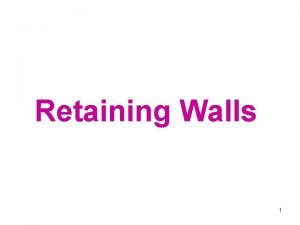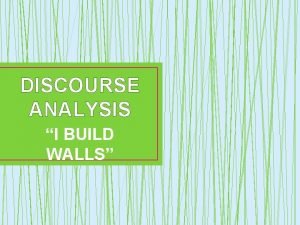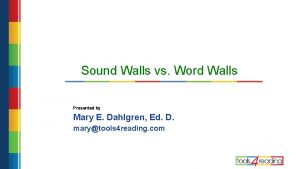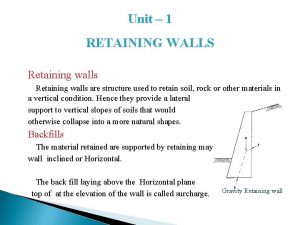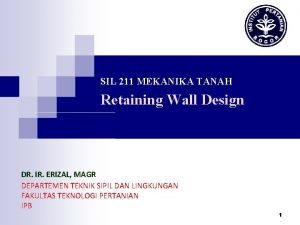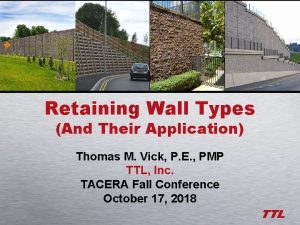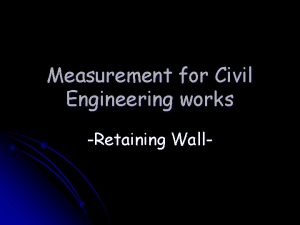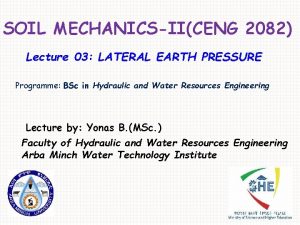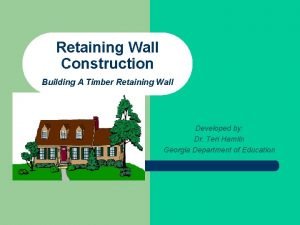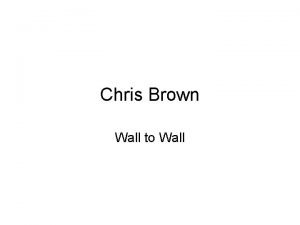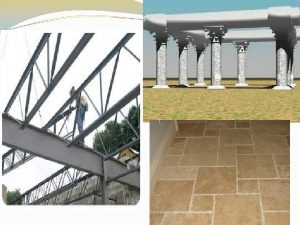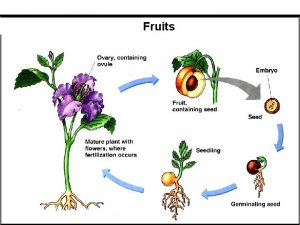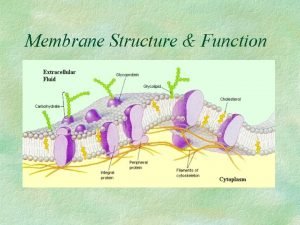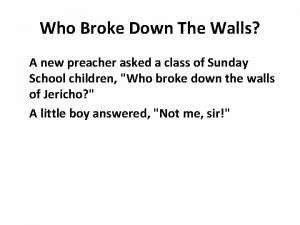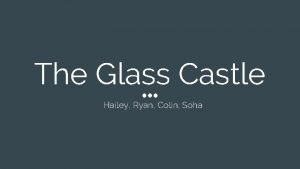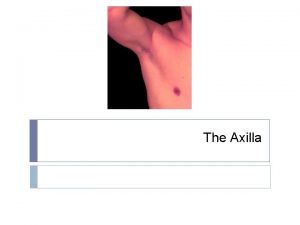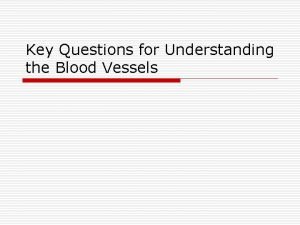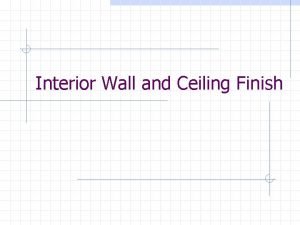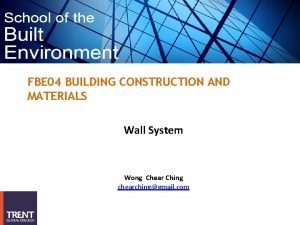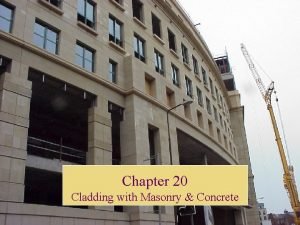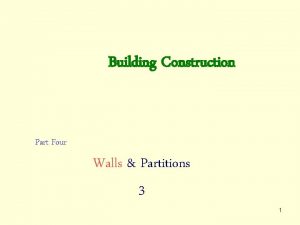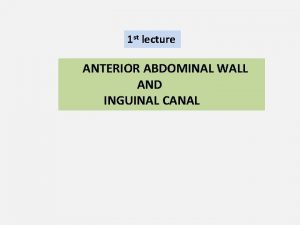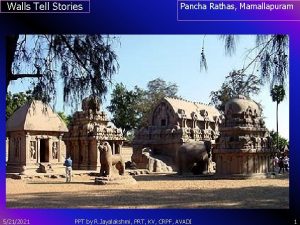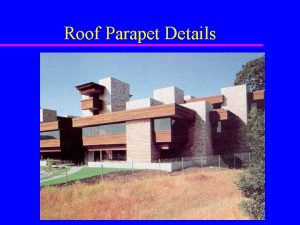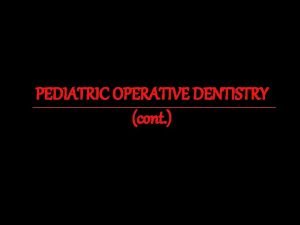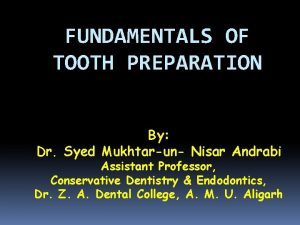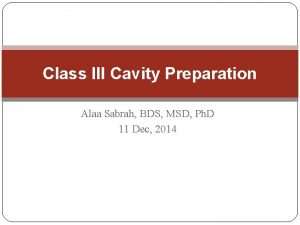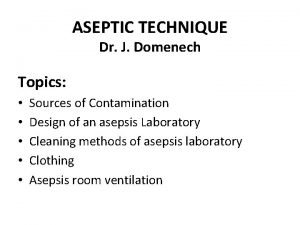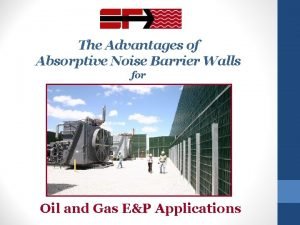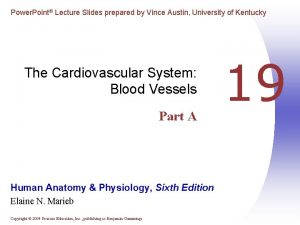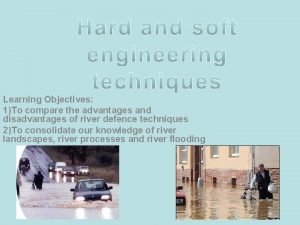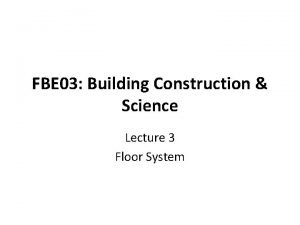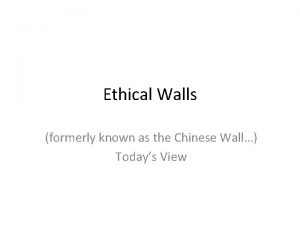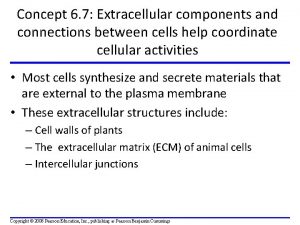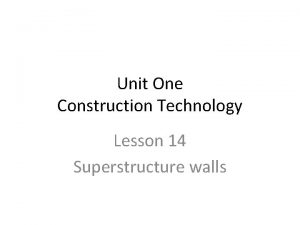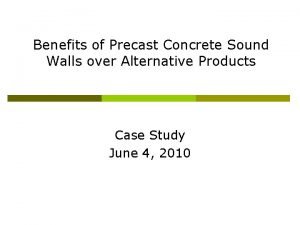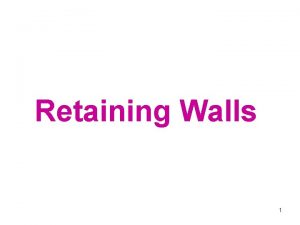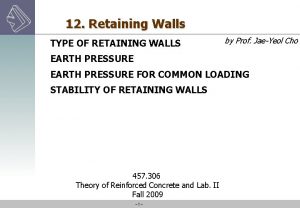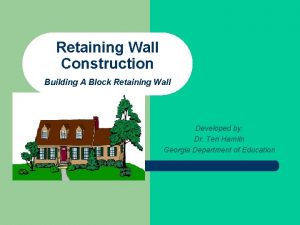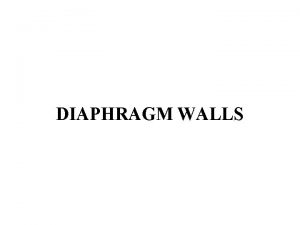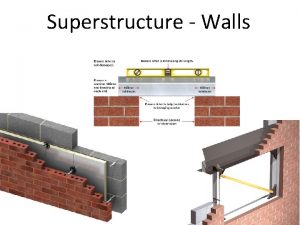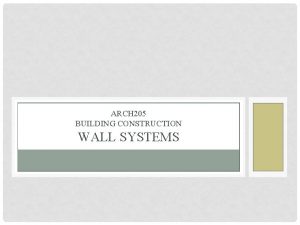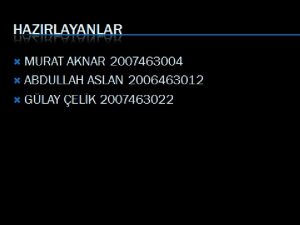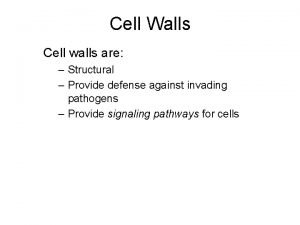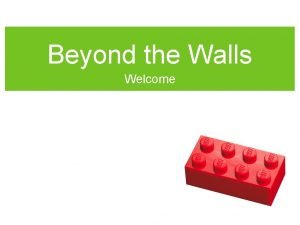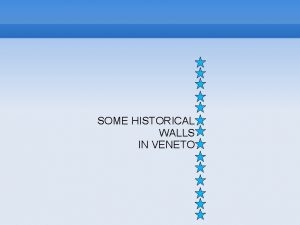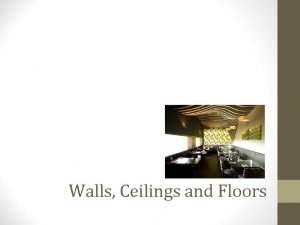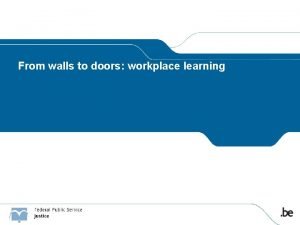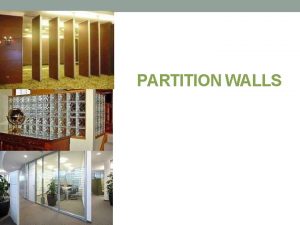Retaining Walls 1 Function of retaining wall Retaining








































![Solution Design of Heel Cantilever Now Wu=(1. 7)(120)(8)+(1. 4)[(17. 5)(120)+(2. 5)(150)] = 5097 lb/ft Solution Design of Heel Cantilever Now Wu=(1. 7)(120)(8)+(1. 4)[(17. 5)(120)+(2. 5)(150)] = 5097 lb/ft](https://slidetodoc.com/presentation_image_h2/000ae547ab9a598f6bdacd0539d382f4/image-41.jpg)


















- Slides: 59

Retaining Walls 1

Function of retaining wall Retaining walls are used to hold back masses of earth or other loose material where conditions make it impossible to let those masses assume their natural slopes. Ø Such conditions occur when the width of an excavation, cut, or embankment is restricted by conditions of ownership, use of the structure, or economy. For example, in railway or highway construction the width of the right of way is fixed, and the cut or embankment must be contained within that width. ØSimilarly, the basement walls of the buildings must be located within the property and must retain the soil surrounding the base. 2

Types of retaining walls Free standing retaining walls, as distinct from those that form parts of structures, such as basement walls, are of various types. Ø The gravity retaining wall retains the earth entirely by its own weight and generally contains no reinforcement. It is used up to 10 ft height. Ø The reinforced concrete cantilever retaining wall consists of the vertical arm that retains the earth and is held in position by a footing or base slab. In this case, the weight of the fill on top of the heel, in addition to the weight of the wall, contributes to the stability of the structure. Since the arm represents a vertical cantilever, its required thickness increase rapidly, with increasing height. It is used in the range of 10 to 20 ft height. 3

Types of retaining walls In the counterfort wall the stem and base slab are tied together by counterforts which are transverse walls spaced at intervals and act as tension ties to support the stem wall. Counterforts are of half or larger heights. Counterfort walls are economical for heights over 25 ft. Property rights or other restrictions sometimes make it necessary to place the wall at the forward edge of the base slab, i. e. to omit the toe. Whenever it is possible, toe extensions of one-third to one -fourth of the width of the base provide a more economical 4 solution.

Types of retaining walls A buttress wall is similar to a counterfort wall except that the transverse support walls are located on the side of the stem opposite to the retained material and act as compression struts. Buttress, as compression elements, are more efficient than the tension counterforts and are economical in the same height range. A counterfort is more widely used than a buttress because the counterfort is hidden beneath the retained material, whereas the buttress occupies what may otherwise be usable space in front of 5 the wall.

Types of retaining walls This is an free standing wall category. A wall type bridge abutment acts similarly to a cantilever retaining wall except that the bridge deck provides an additional horizontal restraint at the top of the stem. Thus this abutment is designed as a beam fixed at the bottom and simply supported or partially restrained at the top. 6

Earth Pressure Ø For liquid P=wwh, ww is the unit weight of water. ØSoil retaining structure Ph=kowh Ø w is unit weight of the soil Ø k 0 is a constant known as the coefficient of earth pressure at rest According to Rankin, the coefficient for active and passive earth pressure are Ø For the case of horizontal surface =0 7

Earth pressure for common condition of loading 8

Earth pressure for common condition of loading 9

Stability Requirement 1. Individual parts should be strong enough to resist the applied forces 2. The wall as a whole should be stable against (i) Settlem ent (ii) Sliding (iii) Overtur ning 10

Stability Requirement Settlement It is necessary to ensure that the pressure under the footing does not exceed the “permissible bearing pressure” for the particular soil. By the formula Ø If , compression will act throughout the section 11

Stability Requirement Settlement Unit dimension in the direction perpendicular to the paper. 12

Stability Requirement Settlement 13

Stability Requirement Settlement 14

Stability Requirement Sliding F = Rv Overturning 15

Basis of Structural Design 1. Lateral earth pressure will be considered to be live loads and a factor of 1. 6 applied. 2. In general, the reactive pressure of the soil under the structure at the service load stage will be taken equal to 1. 6 times the soil pressure found for service load conditions in the stability analysis. 3. For cantilever retaining walls, the calculated dead load of the toe slab, which causes moments acting in the opposite sense to those produced by the upward soil reaction, will be multiplied by a factor of 0. 9. 16

Basis of Structural Design 4. For the heel slab, the required moment capacity will be based on the dead load of the heel slab itself, plus the earth directly above it, both multiplied by 1. 2. 5. Surcharge, if resent, will be treated as live load with load factor of 1. 6. The upward pressure of the soil under the heel slab will be taken equal to zero, recognizing that for severe over load stage a non linear pressure distribution will probably be obtained, with most of the reaction concentrated near the toe. 17

Drainage Ø Reduction in bearing capacity. Ø Hydrostatic pressure. Ø Ice pressure v Drainage can be provided in various ways i. Weep holes, 6 to 8 in. 5 to 10 ft horizontally spaced. 1 ft 3 stone at rear end at the bottom weep holes to facilitate drainage and to prevent clogging. ii. Longitudinal drains embedded in crushed stone or gravel, along rear face of the wall. iii. Continuous back drain consisting of a layer of gravel or crushed stone covering the entire rear face of the wall with discharge at the ends. 18

Problem Ø A gravity retaining wall consisting of plain concrete w=144 lb/ft 3 is shown in fig. The bank of supported earth is assumed to weigh 110 lb/ft 3 ø=300 and to have a coefficient of friction against sliding on soil of 0. 5. Solution 19

Solution Ø Restoring moment: Ø Moment about toe Component Force Weights Moment arm Moment W 1 (6)(4)(144) 864 x 3 2592 lb. ft W 2 (1)(144) 1584 x 1 1584 lb. ft W 3 (4)(144)(11) 8976 lb. ft W 4 (4)(110) 10083. 33 lb. ft W 5 (0. 5)(110) 605 x 5. 75 3478. 75 lb. ft Rv = 8641 lb M=26714. 08 lb. ft Safety factor against overturning = O. K 20

Solution Ø Distance of resultant from the toe Ø Thus resultant is out of kern distance Ø The max. soil pressure will be Ø q = 3080. 57 lb/ft 2 < 4000 psf 21

Solution Sliding Ø Assuming that soil above footing toe has eroded and thus the passive pressure is only due to soil depth equal to footing thickness. Ø Friction force between footing concrete and soil. Ø F. O. S. against sliding = O. K 22

Estimating size of cantilever retaining wall Height of Wall Ø The base of footing should be below frost penetration about 3’ or 4’. Stem Thickness. Ø Stem is thickest at its base. They have thickness in the range of 8 to 12% of overall height of the retaining wall. The minimum thickness at the top is 10” but preferably 12”. Base Thickness Ø Preferably, total thickness of base fall between 7 and 10% of the overall wall height. Minimum thickness is at least 10” to 2312” used.

Estimating size of cantilever retaining wall Ø Base Length For preliminary estimates, the base length can be taken about 40 to 60% of the overall wall height. Ø Another method refer to fig. W is assumed to be equal to weight of the material within area abcd. Ø Take moments about toe and solve for x. 24

Problem Ø Design a cantilever retaining wall to support a bank of earth of 16 ft height above the final level of earth at the toe of the wall. The backfill is to be level, but a building is to be built on the fill. Ø Assume that an 8’ surcharge will approximate the lateral earth pressure effect. Weight of retained material = 130 lb/ft 3 Angle of internal friction = 35 o Coefficient of friction b/w concrete and soil = 0. 4 fc’=3000 psi fy=40, 000 psi Maximum soil pressure = 5 k/ft 2 25

Solution Height of Wall Ø Allowing 4’ for frost penetration to the bottom of footing in front of the wall, the total height becomes. Ø h = 16 + 4 = 20 ft. Thickness of Base Ø At this stage, it may be assumed 7 to 10% of the overall height h. Ø Assume a uniform thickness t = 2’ ( 10% of h ) Base Length Ø h = 20’ h’ = 8’ 26

Solution 27

Solution Ø Moments about point a Ø W = (120)(x)(20+8) = 3360 x lb Ø Ø Ø x = 7. 54 ft Ø So base length = 1. 5 x x = 11. 31 ft Use 11 ft 4” with x = 7’-8” and 3’-8’ toe length 28

Solution Stem Thickness Ø Prior computing stability factors, a more accurate knowledge of the concrete dimensions is necessary. Ø The thickness of the base of the stem is selected with the regard for bending and shear requirements. Ø P for 18’ height and h’ = 8’ 29

Solution Ø Mu = (1. 7) Py = (1. 7) (9951. 12) (7. 412) = 125388. 09 lb. ft For adequate deflection control, choose 30

Solution Ø Total thickness = 16. 7 + 0. 5 + 3 = 20. 26” Try 21” thickness of base of stem and select 12” for top of the 31 wall

Solution Shear at d d used now = 17. 5” = 1. 458’ Ø At 18’ – 1. 458’ = 16. 542’ from top 32

Solution F. O. S Against Overturning Component Force Arm W 1 (5. 92)(18)(120)=12787. 2 W 2 (0. 75)(18)(150)=1012. 5 W 3 (18)(1)(150)=2700 W 4 (11. 33)(2)(150)=3399. 00 W 5 W 6 Total (18)(0. 75)(120)=810 (6. 67)(8)(120)=6403. 2 27111. 9 Moment 107156. 74 3. 67+1+0. 25=4. 92 4981. 50 3. 67+0. 5=4. 17 11259 19255. 34 3. 67+1+0. 5=5. 17 4187. 7 51257. 62 33 198097. 9

Solution Ø P = 11707. 2 lb y= 8. 148 ft Ø Overturning Moment = 11707. 2 x 8. 148 = 95390. 27 lb. ft F. O. S. against overturning O. K Location of Resultant & Footing Soil Pressure Ø Distance of the resultant from the front edge is Ø Middle third = 3. 7778 ft, So resultant is within the middle third. 34

Solution q 1= 4771. 12 lb/ft 2 < 5 k/ft 2 So O. K against bearing pressure. 35

Solution F. O. S. against sliding Ø force causing sliding = P = 11707. 2 lb Ø Frictional resistance = R Ø = (0. 4) (27111. 9) Ø = 10844. 76 lb Ø Passive earth pressure against 2’ height of footing 36

Solution Ø The front of key is 4” in front of back face of the stem. This will permit anchoring the stem reinforcement in the key. . Ø Frictional resistance between soil to soil = R 37

Solution Ø Frictional resistance between heel concrete to soil = R Ø F. O. S. against sliding = 1. 5 So use key of height = 2’-3” = 2. 25’ 38

Solution Design of Heel Cantilever Wu = (1. 7) (120) (8) + (1. 4) [18 x 120 + 2 x 150 ] = 5076 lb/ft Vu = Factored shear a joint of stem and heel When the support reaction introduces compression into the end region, then critical shear is at a distance d from face of support. However, the support is not producing compression, therefore, critical shear is at joint of stem and heel. 39

Solution Design of Heel Cantilever Vu = Factored shear a joint of stem and heel = (5. 92) (5076) = 30049. 92 lb Ø So depth is required to be increased. Ø Therefore heel thickness 30”, d = 27. 5” 40
![Solution Design of Heel Cantilever Now Wu1 712081 417 51202 5150 5097 lbft Solution Design of Heel Cantilever Now Wu=(1. 7)(120)(8)+(1. 4)[(17. 5)(120)+(2. 5)(150)] = 5097 lb/ft](https://slidetodoc.com/presentation_image_h2/000ae547ab9a598f6bdacd0539d382f4/image-41.jpg)
Solution Design of Heel Cantilever Now Wu=(1. 7)(120)(8)+(1. 4)[(17. 5)(120)+(2. 5)(150)] = 5097 lb/ft 41

Solution Ø As = min bd = 1. 8 in 2 Ø Use # 8 @ 5” c/c (As = 1. 88 in 2 ) Ø Dev. Length required = 23” top bars so 23 × 1. 3 = 29. 9” Ø Available = 5. 92’-3” = 68. 04” O. K Design of Toe Slab x = 3215. 7 + 14. 74 = 3230. 44 Self load=(0. 9)(1× 2× 150)=270 lb/ft { (6801. 33)lb/ft Wu = 3801. 33 lb/ft – 270 = 6531. 33 Overload factor = 0. 9 d=24”-3. 5”=20. 5” =1. 71 ft 42

Solution So min will control As = (0. 005)(12)(20. 5) = 1. 23 in 2 Use # 8 @ c/c (As = 1. 26 in 2) Ø Available dev. Length = 3. 76’ – 3” = 41. 01” Required = 23” At a distance d= 20. 5” = 1. 71’ 3. 67’ – 1. 71’ = 1. 96’ 43

Solution Earth pressure Vu = 14526. 55 – 270 x 1. 96 = 13997. 37 lb Ø So no shear reinforcement is required Reinforcement for stem 44

Solution Reinforcement for stem 45

Solution At 5’ from top P=1707. 3 lb y=2. 302’ Mu=6681. 34 lb. ft =6. 68 k. ft At 10’ from top P=4227. 6 lb y=4. 36’ Mu=31334. 97 lb. ft =31. 33 k. ft At 15’ from top P=7560. 9 lb y=6. 29’ Mu=80848. 7 lb. ft =80. 85 k. ft 46

Solution With Full Reinforcement Ø C = 0. 85 fc’ba = 0. 85 × 3000 × 12 × a = 30600 a lb Ø T = Asfy = 2. 67 x 40000 = 106800 Ø a = 3. 49 in Ø At top of wall At base of stem d = 8. 5” d=17. 5” 47

Solution With half Reinforcement Ø C = 0. 85 fc’ba = 0. 85 × 3000 × 12 × a = 30600 a lb Ø T = Asfy = 1. 335 × 40, 000 = 53400 for #9@9” c/c(As=1. 33 in 2) Ø a = 1. 745 in Ø At top of wall At base of stem d = 8. 5” d=17. 5” 48

Solution With one-fourth Reinforcement Ø C = 0. 85 fc’ba = 0. 85 × 3000 × 12 × a = 30600 a lb Ø T = Asfy = 0. 67 × 40, 000 = 26800 for #9@18” c/c(As=0. 67 in 2) Ø a = 0. 88 in Ø At top of wall At base of stem d = 8. 5” d=17. 5” 49

Solution Ø Thus half bars should be cut at 4’-8” distance from bottom and further half bars should be cut 8’-8” theoretically from bottom. Ø The actual termination point is found by extending beyond the intersection of capacity moment line with the factored moment diagram a distance of either the effective depth d or 12 bar diameters, whichever is greater. 50

Solution 51

Solution d at 4. 6’ from bottom (y=12. 9’) = 8. 5 + 6. 63 = 15. 13” 15” d at 8. 6’ from bottom (y=8. 9’) = 8. 5 + 4. 58 = 13. 08” 13” 52

Solution Ø bar used # 9 of diameter = 1. 128” Ø 12 db = 13. 54” = 14” Ø Therefore half bars should be terminated actually at -8”+15”=15’-11” from bottom 4’ Ø and further half bars should be terminated at -8”+14” =9’ 10” 8’ Ø For tension bars to be terminated in the tension zone, one of the following condition must be satisfied. 1. Vu at the cut-off point must not exceed two-thirds of the shear strength øVn. 2. Continuing bars must provide at last twice the area required for bending moment at the cut off point. 3. Excess shear reinforcement is provided. Ø at 12. 9’ from top 53

Solution 54

Solution Ø Condition (1) satisfied so bars can be terminated. The above condition are imposed as a check stress concentration. Ø Shear at bottom = Vu = 1. 7 x 9. 53243 = 16. 21 kips Since øVc > Vu so no need of shear reinforcement. 55

Solution Ø The used should not be less than at any point. This minimum limit, strictly speaking, does not apply to retaining walls. However, because the integrity of retaining wall depends absolutely on the vertical walls, it appear prudent to use this limit un such cases. Ø First termination point is 5’-11” from bottom where d=14. 46” As =1. 335 in 2 Ø Second termination point is 9’-10” form bottom where d=12. 44” As=0. 6675 in 2 = 0. 0045 ≈ 0. 005 Therefore the above condition is satisfied. 56

Solution Ø Another requirement is that maximum spacing of the primary flexural reinforcement exceed neither 3 times the wall thickness nor 18 in. These restrictions are satisfied as well. Ø For splices of deformed bars in tension, at sections where the ratio of steel provided to steel required is less than 2 and where no more than 50% of the steel is spliced, the ACI code requires a class-B splice of length 1. 3 ld. Ø ld for # 9 bars =29” Ø Splice length = 1. 3 × 29 = 37. 7” or 3’-2” O. K 57

Solution Temperature & shrinkage reinforcement Ø Total amount of horizontal bars (h is average thickness) Ø Since front face is more exposed for temperature changes therefore two third of this amount is placed in front face and one third in rear face. Accordingly Ø # 4 @ 9 in. c/c As=0. 26 in. Use # 3 @ 10 in. c/c As=0. 13 in 2. Ø For vertical reinforcement on the front face, use any nominal amount. Use # 3 @ 18 in. c/c Since base is not subjected to extreme temperature changes, 58 therefore # 4@ 12” c/c just for spacers will be sufficient.

Solution 59
 Below are the functions of retaining wall except
Below are the functions of retaining wall except I build walls poem
I build walls poem Sound word wall
Sound word wall Curtailment of bars in retaining wall
Curtailment of bars in retaining wall Mekanika tanah 1
Mekanika tanah 1 What is retaining wall
What is retaining wall Mass concrete retaining wall
Mass concrete retaining wall Types of lateral earth pressure
Types of lateral earth pressure Building a timber retaining wall
Building a timber retaining wall Chris brown wall to wall
Chris brown wall to wall Disadvantages of cavity wall
Disadvantages of cavity wall Members used to carry wall loads over wall openings
Members used to carry wall loads over wall openings Lemon diagram
Lemon diagram A tissues
A tissues Protein transport
Protein transport Cell wall function
Cell wall function Middle lamella
Middle lamella Mitochondria nickname and function
Mitochondria nickname and function Who broke down the walls of jericho
Who broke down the walls of jericho 93 little hobart street welch wv
93 little hobart street welch wv Axillary muscles
Axillary muscles King jesus you're the name
King jesus you're the name School wide data walls
School wide data walls These vessels have thicker walls and a heavier tunica media
These vessels have thicker walls and a heavier tunica media Interior finishing materials
Interior finishing materials What are interior walls made of
What are interior walls made of Ecg walls
Ecg walls Datawalls
Datawalls Masonry veneer curtain walls:
Masonry veneer curtain walls: Four walls construction
Four walls construction Vertical walls
Vertical walls Walls tell stories class 5 ppt
Walls tell stories class 5 ppt Concrete roof parapet detail
Concrete roof parapet detail In marble walls as white as milk
In marble walls as white as milk Class 2 cavity preparation pediatric
Class 2 cavity preparation pediatric Kingdom fungi cell wall
Kingdom fungi cell wall Retention locks grooves and coves
Retention locks grooves and coves Dr mariyam walls
Dr mariyam walls Beveled conventional cavity design
Beveled conventional cavity design Axial wall
Axial wall Cell organelle graphic organizer
Cell organelle graphic organizer Asepsis in walls
Asepsis in walls Figure of speech in far far from gusty waves
Figure of speech in far far from gusty waves Killer robot
Killer robot Absorptive noise barrier
Absorptive noise barrier Dialysis membrane
Dialysis membrane Prokaryotic cells
Prokaryotic cells Vince have thinner walls than arteries
Vince have thinner walls than arteries Are plants multicellular eukaryotes
Are plants multicellular eukaryotes Flood warning systems advantages and disadvantages
Flood warning systems advantages and disadvantages Inlay vs amalgam
Inlay vs amalgam Suspended timber upper floor
Suspended timber upper floor Ethical wall definition
Ethical wall definition Channels that perforate plant cell walls
Channels that perforate plant cell walls Superstructure walls
Superstructure walls Arteries walls
Arteries walls Aurelian walls map
Aurelian walls map Sandra walls
Sandra walls Precast concrete sound walls
Precast concrete sound walls The walls come crumbling down
The walls come crumbling down
